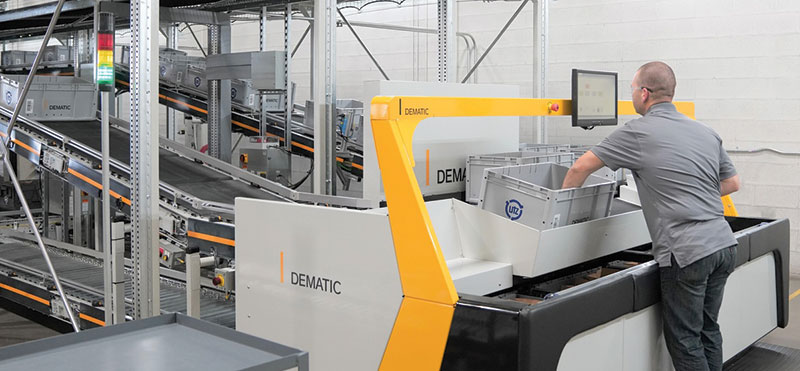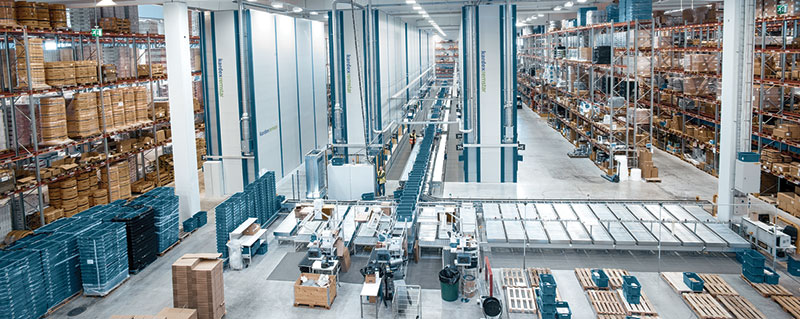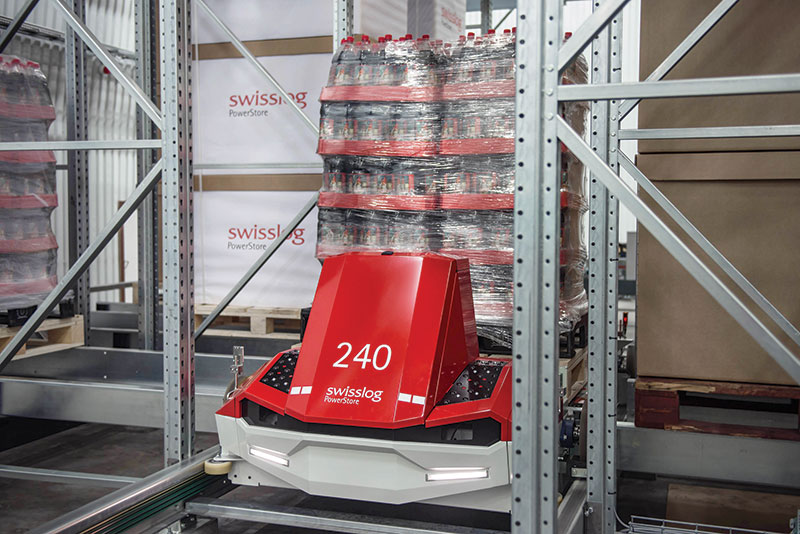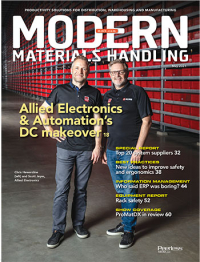Utilizing Automated Storage for Labor Shortages and Other Warehouse Challenges
Running out of space and grappling with issues like the persistent labor shortage, warehouse and DC operators are looking to automated storage and retrieval solutions for help solving these and other challenges.
Focused on optimizing picking processes and improving efficiencies, automated storage and retrieval systems (AS/RS) are helping companies maximize floor space, increase storage capacity, and make better use of vertical space in an era where many facilities are running out of space and grappling with a persistent national labor shortage.
By reducing the amount of time operators spend walking the warehouse floor and searching for items, AS/RS solutions help reduce operational costs; speed up the picking and packing process; improve inventory control; and free up valuable human labor to focus on something other than repetitive storage and retrieval tasks.
These and other benefits have garnered the attention of companies that were already dealing with a labor shortage pre-Covid, and have been dealing with a huge uptick in e-commerce orders since early 2020.
Whether they’re investing in their first automated storage solution or adding to an existing AS/RS setup, companies are driving this corner of the warehouse automation market to new heights. In the United States, for example, reports forecast the AS/RS market is on track to reach $9.16 billion by 2025 (up from $7.18 billion in 2019).
Beneficial in warehouse and DC applications, AS/RS solutions help companies maximize floor space while automating the flow and control of materials. Because they can handle variability, variety and volume at higher speeds, AS/RS can also help organizations minimize their reliance on labor and adhere to new social distancing rules in the workplace.

Interest in micro-fulfillment is picking up as companies both in and out of the food industry look for new ways to leverage non-traditional fulfillment spaces.
Norman Leonhardt, director of business development at Witron, says these and other factors are driving more companies to explore their automated storage options. “Demand is definitely spiking,” says Leonhardt. “Even the economic slowdown in 2020 due to the pandemic hasn’t stopped the need for automated storage and warehouse automation in general.”
From their automated storage vendors, companies are looking for more temperature-controlled (both refrigerated and frozen) options, says Leonhardt. They also want to be able to store goods in an FDA-compliant manner (e.g., not storing certain goods next to one another due to the risk of spillage). “These are some of the customer requests we’re hearing right now,” says Leonhardt.
Companies also want to be able to store certain goods closer to an exit area to ensure that a cold shipment is ready to load the following morning, for example. This is the type of work that can be done overnight by an automated system. “Automated storage doesn’t sleep. It can work 24 hours a day,” says Leonhardt. “Using historical data, it can learn which products are in most demand on a certain day and pull those orders and place them near the storage exit.”
As with any type of technology, automated storage and retrieval systems are also getting faster and able to handle more capacity than they could when they first came on the scene. At Witron, for example, Leonhardt says that the cranes are able to manage bigger loads and within less time than they required just a few years ago. “Back in the day, one small crane could carry four cases of goods,” he says. “That’s now up to eight cases, so capacity has basically doubled.”

Without much floor space to spare, warehouse operators are looking upward and wanting to make better use of their vertical space.
Business is brisk
Business has also been brisk this year for AutoStore, where business development manager Michael Pietras is seeing “significant interest” in flexible, adaptable automated systems that can be customized to an individual company’s needs. “Much of that is being driven by Covid and the events of 2020, where we saw an accelerated need for e-commerce,” he says. “The rapid changes that took place created a desire for automated equipment that can keep up with those changes.”
To help its customers adapt to those shifts, AutoStore introduced its Router software last year. Using computer algorithms, the product continuously calculates and recalculates the most efficient path for robot movement in real time. “The Router increases the performance of our components by up to 40%,” Pietras says. To keep up with increased demand for AS/RS, the company also set up a rapid-deployment model, whereby it can get systems up and running in 12 to 14 weeks.
At Dematic, John Mart, vice president of product management, says that the company is also seeing high demand for its automated storage and retrieval products. Much of that interest is coming from the food, beverage and grocery sectors, but other industries are also getting on board with the automated warehousing movement.
“There’s a huge wave of demand right now,” says Mart. “We’re starting to see some of the technologies we’ve been talking about for a while becoming more ‘real’ [within] the solutions that are being offered.” Within the food and beverage space, for example, technology that supports flexible, mixed-case fulfillment is gaining in popularity. According to Mart, these and other solutions help reduce their physical footprints, integrate robotic technologies, and leverage smart software to run more dynamic operations.
Mart says interest in micro-fulfillment is also picking up as companies both in and out of the food industry look for new ways to leverage non-traditional fulfillment spaces (e.g., shopping malls, empty retail stores, etc.). “They’re looking to integrate automated storage systems into environments that in the past may have had completely different personnel profiles,” he adds.
Constantly tweaking the systems
With the increase in e-commerce orders forcing most warehouses and DCs to operate differently than they did just three to four years ago, more of them are turning to automation for help. With picking and packing comprising a good bulk of the typical facility’s labor spend, it makes sense that today’s advanced AS/RS solutions would be getting a lot of attention right now.
Bruce Gonzales, regional business director at Kardex Remstar, doesn’t see that trend letting up anytime soon. “Order profiles are changing and everyone wants their shipments immediately,” says Gonzales, who is also seeing increased demand for storage systems that can handle large, bulky items (for example, those goods that are larger than the standard pallet). Without much floor space to spare, warehouse operators are looking upward and wanting to make better use of their vertical space.
To meet that demand, Kardex Remstar manufactures vertical lift modules (VLMs). The company also offers a Cloud-based Remote Support platform that continuously monitors the status of installed systems and remotely maintains them as needed. Gonzales says the software helps companies optimize their AS/RS investments by continually honing and adjusting them over time.
“When you design a VLM, it’s crucial to slot materials wisely for fast and accurate picking,” says Gonzales. Those requirements can change over time as the market shifts or other outside forces come into play. When that happens, the original setup doesn’t necessary shift along with those changes. “With Remote Support, we can let a company know that it’s using one VLM 90% of the time and hardly using its other two modules,” Gonzales says, “and that’s time to re-slot and get everything rolling like a well-oiled machine.”
No new space available
With CBRE Research estimating that every $1 billion incremental increase in e-commerce sales will translate into demand for an additional 1.25 million square feet of warehouse space—and with net absorption of industrial space on track to reach nearly 250 million square feet this year—the race to balance growing e-commerce fulfillment orders with less physical space is on.
“It’s going to be hard to get new space in the short-term,” says Swisslog’s vice president of sales and consulting Robert Nilsson. “Because of this, companies need to be more efficient with their storage at a time when they can’t afford to run out of inventory.”
Companies looking to achieve this balance are turning to Swisslog’s AutoStore for help, Nilsson says. This automated system, which is made by AutoStore and implemented by others, uses robots and bins to process small parts orders, enabling direct stacking of bins on top of each other and storage of multiple SKUs in a single bin. Swisslog’s new CarryPick automated storage and picking system finds a swarm of mobile vehicles (KMP600) navigating on a grid to deliver mobile racks to workstations for picking and reducing the travel path for workers.
When shopping around for these types of AS/RS solutions, Nilsson says companies should look for automation that can handle the desired level of speed and throughput. Remember that automation is a complex animal that includes equipment, devices and software, and that those components are all interdependent. And once the components are in place, make sure you have a plan in place for maintaining the equipment and maximizing your investment over time.
“Consider how much support you can do yourself, and how much support you need from your suppliers,” Nilsson advises. “Then, find a technology partner that either takes a proactive approach to keeping your system running and making practical suggestions, or that steps back and lets you manage it (if so desired).”

Article Topics
Storage News & Resources
Walmart chooses Swisslog AS/RS and software for third milk processing facility Steele Solutions showcases advanced structural steel platforms and materials handling chutes HWArobotics delivers advanced AS/RS technology to e-commerce specialist Darwynn Frazier shows Pallet Spacing System and Method Steel King Industries announces strategic collaboration with Automha Americas Kardex FulfillX for AutoStore can help businesses meet goals in under 6 months The Stow Group puts the spotlight on its Movu Robotics brand More StorageLatest in Materials Handling
Registration open for Pack Expo International 2024 Walmart chooses Swisslog AS/RS and software for third milk processing facility NetLogistik partners with Vuzix subsidiary Moviynt to offer mobility solutions for warehouses Materials Handling Robotics: The new world of heterogeneous robotic integration BSLBATT is looking for new distributors and resellers worldwide Lucas Watson appointed CSO for Körber’s Parcel Logistics business in North America Hyster recognizes Dealers of Distinction for 2023 More Materials HandlingAbout the Author
Subscribe to Materials Handling Magazine

Find out what the world's most innovative companies are doing to improve productivity in their plants and distribution centers.
Start your FREE subscription today.
April 2024 Modern Materials Handling

Latest Resources












